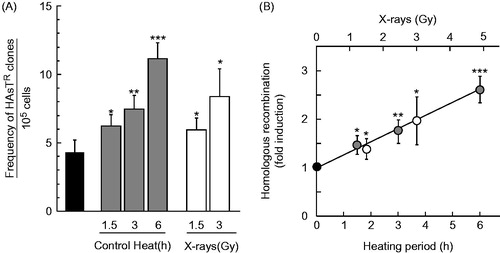Figures & data
Figure 1. Effect of B02 or NU7026 on cell death induced by heat shock or X-rays in human cancer cell lines. Colony-forming survival assay. A172 (wtp53) and U251MG (mp53) cells were heat-treated at 44 °C for 10 min or irradiated with X-rays (2 Gy) in the presence of B02 or NU7026 at the indicated concentrations. Filled circles, inhibitor alone; grey triangles, heat shock; open triangles, X-rays. *, ** and *** represent p < .05, p < .01 and p < .001, respectively.

Figure 2. Effect of B02 or NU7026 on heat-induced cell death in human cancer cell lines. (A) Colony-forming survival assay. A172 (wtp53) and U251MG (mp53) cells were heat-treated at 44 °C for the indicated times in the presence of B02 (10 μM) or NU7026 (10 μM). Filled circles, no inhibitor; grey triangles, B02; open triangles, NU7026. (B) SER of inhibitors at 10% survival rate. Filled columns, no inhibitor; grey columns, B02, open columns, NU7026. *** represents p < .001.
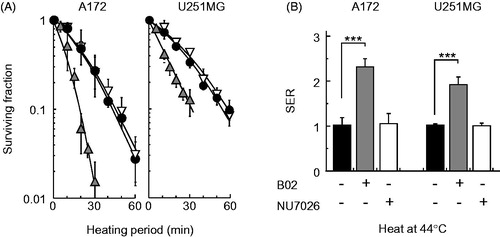
Figure 3. Effect of B02 or NU7026 on heat-induced cell death at different cell cycle phases. H1299 cells were synchronised at G1 and G2 phases, exposed to heat at 44 °C for 20 min in the presence of B02 (10 μM) or NU7026 (10 μM), and grown until the formation of colonies. Filled columns, no inhibitors; grey columns, B02; open columns, NU7026. ** and *** represent p < .01 and p < .001, respectively.
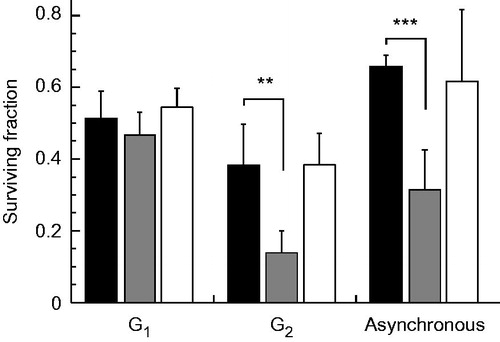
Figure 4. Heat sensitivity and H2AX phosphorylation after heat shock in MEFs. (A) survival assay. The cells were exposed to heat at 45.5 °C for the indicated times and grown until the formation of colonies. Open circles, wild-type; filled circles, Lig4−/−; filled triangles, Rad54−/−; open triangles, Lig4−/−Rad54−/−. (B) H2AX phosphorylation assay. The cells were exposed to heat at 45.5 °C for 20 min and allowed to recover for the indicated times. *, ** and *** represent p < .05, p < .01 and p < .001, respectively.
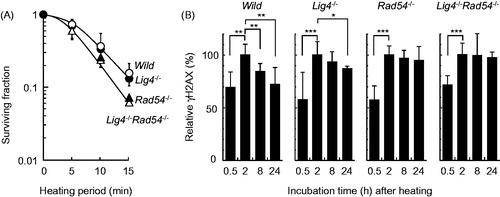
Figure 5. Heat sensitivity of Rad51d-proficient and Rad51d-deficient MEFs. The cells were exposed to heat at 45.5 °C for the indicated times and grown until the formation of colonies. Open circles, wild-type; filled circles, Rad51d−/−+ Rad51d; filled triangles, Rad51d−/−; open triangles, Rad51d−/− + empty vector.
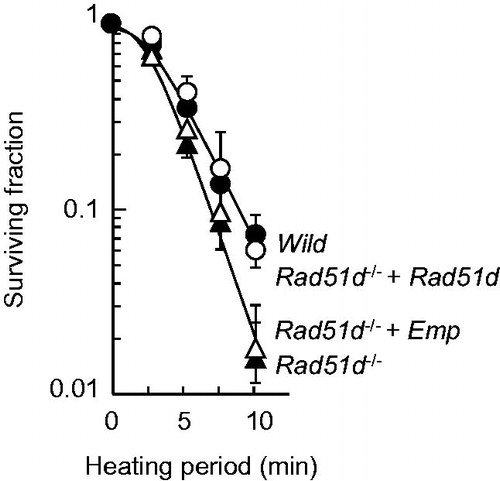
Figure 6. Homologous recombination frequencies induced by heat shock or X-rays in SPD8 cells. The cells were exposed to heat at 42 °C for the indicated times or irradiated with X-rays at the indicated doses and used for recombination assays. (A) frequency of HAsTR clones per 105 cells. (B) fold induction of HR. Grey circles, heat shock; open circles, X-rays. *, ** and *** represent p < .05, p < .01 and p < .001, respectively.
